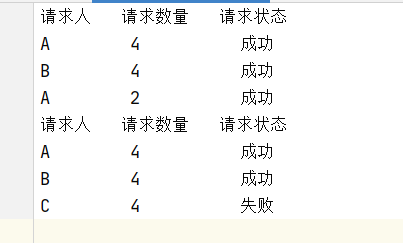临近期末,加上感觉没啥写的,就只能水一水了(不,读书人的事情,怎么能说水呢)
前言
这个是当初学操作系统课写的一个课外作业,写的有点粗糙(不,是非常粗糙),望大家多多包涵。
银行家算法
银行家算法(Banker’s Algorithm)是一个避免死锁(Deadlock)的著名算法,是由艾兹格·迪杰斯特拉在1965年为T.H.E系统设计的一种避免死锁产生的算法。它以银行借贷系统的分配策略为基础,判断并保证系统的安全运行。
运行结果展示

代码展示
下面代码是一个简单实现的java版本,仅供萌新参考(我自己也是),代码里面有详细的注释介绍,如有错误,欢迎给位大佬指点。
Demo1.java
import java.io.*;
import java.util.*;
/**
* @author psl
*/
public class Demo1 {
//已经拥有的资源
static Map<String,Integer> C = new HashMap<>();
//最大需求的资源
static Map<String,Integer> R = new HashMap<>();
//总的资源
static int sum = 10;
//可以利用的资源
static int A = 10;
public static void main(String[] args) throws IOException {
// File algorithm = new File("banker's algorithm");
// BufferedReader reader = new BufferedReader(new FileReader("banker's algorithm"));
//往banker's algorithm.txt文档里面写入各种分配的状态
BufferedWriter writer = new BufferedWriter(new FileWriter(new File("banker's algorithm.txt"),true));
//已经拥有的资源
C.put("A",0);
C.put("B",0);
C.put("C",0);
C.put("D",0);
//最大需求的资源
R.put("A",6);
R.put("B",5);
R.put("C",4);
R.put("D",7);
Scanner sc = new Scanner(System.in);
System.out.println("请输入请求人");
String people = sc.nextLine().toUpperCase();
System.out.println("请输入请求数量");
Integer count = sc.nextInt();
writer.write("请求人 " + "请求数量 " + "请求状态");
writer.newLine();
writer.flush();
while(true){
//判断分配后是不是安全状态
boolean flag = judge(people, count);
if (flag){
Integer cnt = C.get(people);
//如果请求资源已经满足自己最大的需要,就释放所有的资源
if (cnt + count < R.get(people)){
C.put(people,cnt+count);
A = A - count;
}else {
C.put(people,0);
A = A + cnt;
}
System.out.println("请求成功");
writer.write(people + " " + count + " 成功");
writer.newLine();
System.out.println("剩余的资源为"+A);
}else {
System.out.println("请求失败");
writer.write(people + " " + count + " 失败");
writer.newLine();
}
sc.nextLine();
System.out.println("请输入请求人,如果输入N,表示结束循环,否则表示继续");
people = sc.nextLine().toUpperCase();
if (people.equalsIgnoreCase("n")){
break;
}
System.out.println("请输入请求数量");
count = sc.nextInt();
writer.flush();
}
writer.close();
}
/**
* 判断是不是安全状态的方法
* @param people
* @param count
* @return
*/
public static boolean judge(String people,Integer count){
if (count > A) {
return false;
}
//空闲的资源
int spare = A - count;
Set<String> keys = new HashSet<>(R.keySet());
//用来计数已经满足的进程
int cnt = 0;
int size = keys.size();
int i = 0;
while ( true ) {
Set<String> keys1 = new HashSet<>(keys);
// keys1.addAll(keys);
for(String key : keys1){
//总的需要的资源
Integer value = R.get(key);
//目前需要的资源
int need = 0;
if (people .equals(key)){
need = value - C.get(key) - count;
}else {
need = value - C.get(key);
}
//判断剩余的资源是否能够满足需要的资源
if (need <= spare){
//如果满足的是当前请求的资源就走if,否则走else
if (people .equals(key)){
spare += count + C.get(key);
}else {
spare += C.get(key);
}
//移除已经满足的进程
keys.remove(key);
cnt++;
}
//如果满足的进程 = 所有的进程数,就直接返回
if (cnt == size){
return true;
}
}
//一旦cnt = i 就是这一次一个就没满足,所以就失败
if (cnt == i ){
return false;
}
i++;
}
}
}
参考
计算机操作系统(机械工业出版,那本黑皮书)
